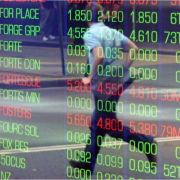Is the market still safe?
| Summary: On one charting scale, the market is trading near its long-term ceiling. On another, it’s trading below and has significant upside. For investors, the best way to track the market is by using medium- and long-term moving averages to highlight the Buy and Sell signals. |
| Key take-out: Indicators show the market’s long-term momentum is still positive, though losing steam. |
| Key beneficiaries: General investors. Category: Shares. |
The best way to view the stockmarket is using a broad share price index like the All Ordinaries, which reflects the share prices of the 500 largest companies listed on the Australian Securities Exchange weighted by market capitalisation.
Below is a chart of the All Ords share price index expressed on a standard arithmetic scale. Note the upward sloping channel that has defined the range within which the index (with one exception) has moved since the creation of a single national stock exchange in 1980.
The one exception was September 2005 to September 2008 when the market shot above the channel’s ceiling and then plunged below its floor by March 2009. Now the index is hugging the ceiling again, prompting speculation that it could fall back to or below the red trend line defining the middle of the channel.
Well that’s the conventional technical view of the Australian sharemarket. But a different picture emerges from using a logarithmic scale to depict the journey of the All Ords index. Because a logarithmic chart shows recent movements in the index in equal proportion to earlier movements, it is not distortionary.
Note how on the logarithmic scale below the All Ords index is trading in the bottom half of its long-term upward channel, suggesting it has significant head space to grow before reaching its long-term red trend line – let alone the blue ceiling originally defined by the breakout of 1987.
Just as there are “lies, damn lies and statistics” there are also lies, damn lies and pattern analysis. What this exercise shows is that the same stockmarket index can suggest diametrically opposite outcomes, depending on how it’s charted. Bears point to the first chart while bulls to the second.
The most important consideration is whether the All Ords price index is above or below its medium- and long-term moving averages and whether the associated momentum measures are positive or negative. Rough proxies for my Active and Conservative strategy trend lines are 80 days and 500 days respectively. I say “rough”, because my charting model uses multiple moving average crossovers plus multiple momentum indicators to generate Buy and Sell signals for each strategy.
Also momentum indicators such as a moving average convergence divergence (MACD) measure and a Coppock indicator help inform when to get back into the market after a correction or crash. As a result, my Buy and Sell signals for indexed equity funds (such as the SPDR/ASX 200 Share Fund) are not as sluggish as those generated by the All Ords share index crossing over its 80-day or 500-day moving average trend line.
The key point to recognise is that whether a moving average is shown on an arithmetic or logarithmic chart, the story stays the same. For instance at present the All Ords index is above both its medium-term (red) and long-term (blue) trend lines whether the chart is arithmetic or logarithmic. In other words, it’s still safe to be in the market. Moreover, the market’s long-term momentum as gauged by the green monthly Coppock indicator is still positive, though losing steam.
Here is a forecast of how things might pan out using a stylised depiction of the stockmarket cycle created by MRB Partners, a global research house that takes a top-down approach to stock and other asset markets.
Shaw Stockbroking thinks the All Ords index is nearing the end of Phase 3, having completed Phase 1 in 2009 and Phase 2 in 2010 and 2011. If it is right the market is in for a 14 week correction of around 17% after which it will rally by 40% over 70 weeks. These figures are rough orders of magnitude, so should not be taken literally.
Shaw’s conclusion that the Australian stockmarket is not cheap is also borne out by trailing and forward price earnings ratios for the world stock markets other than Australia; see next two charts.
Yet market gains have been achieved at the current P/E ratios in the past because markets can defy gravity for long periods.
Percy Allan is a director of MarketTiming.com.au For a free three-week trial of its newsletter and trend-trading strategies for listed ETF funds, see www.markettiming.com.au.
















